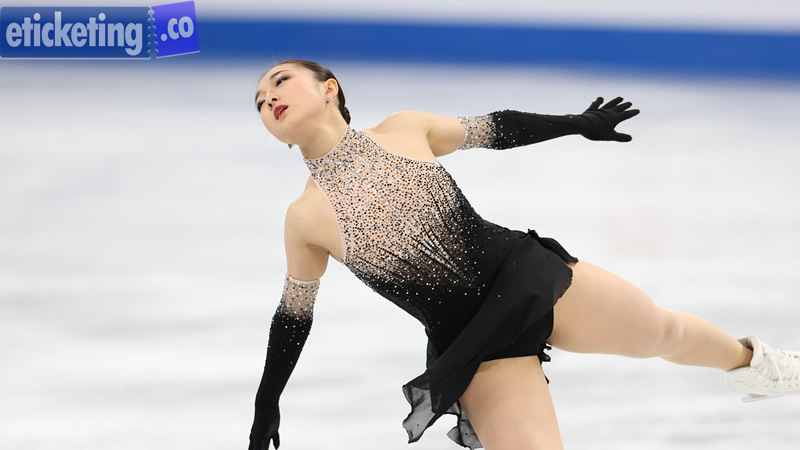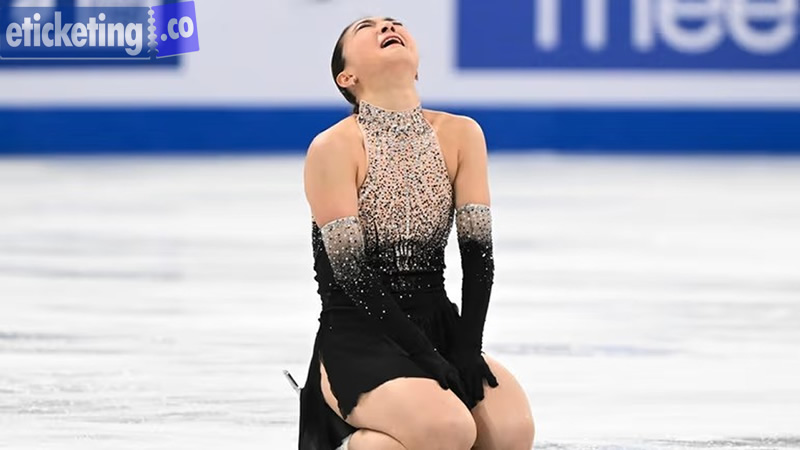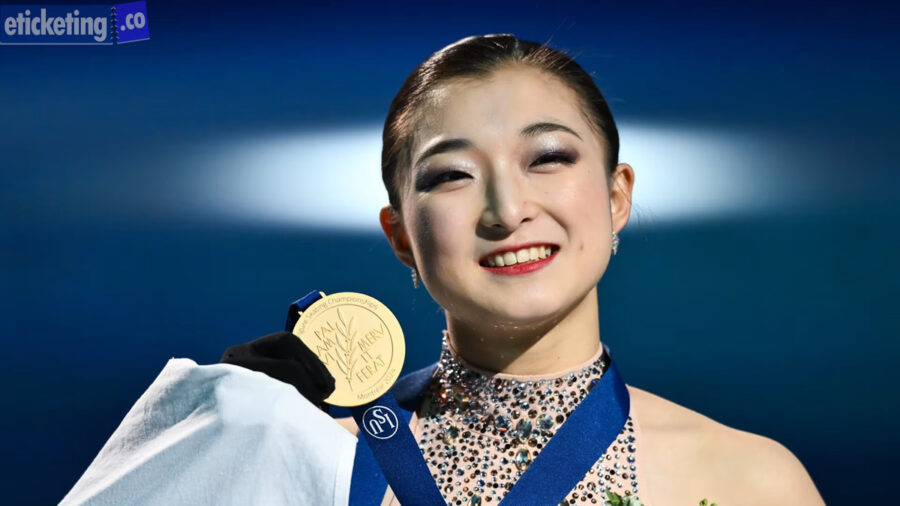For over a decade, Sakamoto Kaori has been a beacon of consistency, strength, and artistry in Winter Olympic figure skating. Now, with the Winter Olympic Milano Cortina 2026 on the horizon, Japan’s reigning icon has announced that she will take her final bow following the Games. It marks the end of an era not just for Japanese Winter Olympic figure skating, but for the global skating community that has come to revere her spirited performances and relentless determination.
Secure your Olympic Figure Skating Tickets now at eticketing.co! Visit our website to grab your tickets at discounted rates and be part of the thrilling action in Milano Cortina 2026. Don’t miss the chance to cheer on your favorite athletes as they go for gold!

Early Steps on Olympic Ice: A Winter Olympic Figure Skating Prodigy in the Making
Born in Kobe, Japan, in 2000, Kaori Sakamoto was introduced to Winter Olympic figure skating at the age of four. Her early career was marked by promise, but it was in her junior years that she began to shine. Winning bronze at the 2017 World Junior Championships foreshadowed what was to come. By 2018, she had made her Olympic debut in Pyeongchang, finishing a solid sixth and helping Japan to a team event fifth-place finish.
Her early promise was built on explosive power, speed across the ice, and an unmistakable tenacity. Even in her teens, Sakamoto exhibited maturity beyond her years—handling pressure with grace and always putting the joy of Winter Olympic figure skating performance above all else.
The Breakthrough and Championship Glory
Sakamoto’s defining moment came at the 2022 Beijing Winter Olympic. With the Russian dominance of women’s skating under intense scrutiny and the event shrouded in controversy, Sakamoto became a symbol of purity and resilience. Her brilliant, clean skate in the women’s singles event earned her a bronze medal—the first Japanese woman to stand on the Olympic podium since Mao Asada’s silver in 2010.
Later that year, she claimed the World Championship title in Montpellier, becoming the first Japanese woman to win the title in eight years. She defended it the following year in Saitama, cementing her legacy with back-to-back world titles—a feat rarely accomplished in modern Winter Olympic figure skating. You Can Read Winter Olympic 2026: Shaidorov Elevates Kazakh Olympic Figure Skating a Decade After Denis Ten
Skating with Heart
Kaori Sakamoto has never been the most technically dominant skater in the field. In an era where quadruple jumps have become standard among elite women, particularly among Russian competitors, Sakamoto has instead leaned on her unrivaled skating skills—speed, edge control, transitions—and powerful triple jumps executed with consistency.
But it is her artistry and emotional authenticity that truly sets her apart. Whether portraying a fierce warrior or an elegant swan, Sakamoto skates with an intensity that commands attention. Her performances are not only athletic feats but emotional journeys, often leaving audiences in tears. Critics and fans alike praise her ability to connect with the music and the audience, qualities that have made her a fan favorite across continents.

An Inspiration in Japan and Beyond
Sakamoto’s rise came during a golden generation of Japanese figure skaters, including Yuzuru Hanyu, Shoma Uno, and Rika Kihira. But unlike some of her peers who soared and faltered, Sakamoto’s story is one of steady growth and late blooming. She was never considered the chosen one—just the one who never stopped improving.
Her resilience is especially noteworthy. After a disappointing 2019–20 season, she rebounded with a new level of maturity, culminating in her Olympic and World successes. She has become a symbol of perseverance, particularly for young athletes facing the rollercoaster nature of elite sport.
In Japan, she is more than just a skater—she is a cultural figure. Her personality—bubbly, self-deprecating, and sincere—has won the hearts of the Japanese public. Her Olympic medal and World titles have been widely celebrated, and she has played a key role in elevating women’s skating in a country that has long revered its male stars.
Skating Toward Goodbye: Sakamoto’s Final Olympic Chapter
Sakamoto’s decision to retire after the Winter Olympic Milano Cortina 2026 is both emotional and pragmatic. At 26, she will be one of the oldest competitors in the women’s field, in a sport where teenage prodigies often dominate. Speaking candidly in a recent interview, she said: I want to give everything I have in my last season. I want to leave the ice with no regrets.
Olympic 2026 fans worldwide can book Winter Olympic Tickets from our online platforms eticketing.co Fans can book Olympic Tickets on our website at discounted prices. Experience the thrill of the Games in Milano Cortina and support your favorite athletes as they compete for glory.

She emphasized the physical and mental toll of the sport, especially with the rise in technical demands and the year-round competitive schedule. Yet she also expressed excitement for her final chapter—an opportunity to skate freely, without pressure, knowing the end is in sight. Her coach, Sonoko Nakano, echoed the sentiment: Kaori has given so much to this sport. Now she wants to end her career on her own terms, as a champion and as an artist.
Beyond the Boards: Sakamoto’s Lasting Impact on Winter Olympic Figure Skating Future
Though she plans to retire from competition, Sakamoto is unlikely to leave the sport entirely. She has expressed interest in coaching, choreography, and performing in ice shows. Given her popularity and charisma, offers will be abundant.
She also has the potential to play a leadership role in Japanese skating governance or athlete advocacy. With firsthand experience of the sport’s highs and lows, she could be a valuable voice in shaping its future.
Moreover, her impact will persist through those she has inspired. Rising Japanese skaters like Hana Yoshida, Rinka Watanabe, and Mone Chiba often cite Sakamoto as a role model. Her influence on the next generation of skaters—particularly those who value artistry as much as technique—will endure long after her final bow.
The Final Season: Sakamoto’s Farewell to Winter Olympic Figure Skating
As the Winter Olympic 2025–26 season approaches, all eyes will be on Sakamoto. Can she end her career with another Olympic medal? Can she withstand the pressure of skating against younger, technically stronger competitors?

Regardless of the outcome, her mere presence will elevate the Games. She represents the soul of the sport—a reminder that Winter Olympic figure skating is as much about expression and passion as it is about jumps and scores. For fans, her farewell season will be a celebration of all she has achieved and contributed. Every skate will carry the weight of legacy, every smile a thank-you to those who have supported her along the way.
Legacy on Ice: Redefining Greatness in Winter Olympic Figure Skating
Kaori Sakamoto may not have redefined the technical boundaries of Winter Olympic figure skating, but she redefined what it means to succeed on your own terms. She rose through the ranks not with dazzling quads, but with heart, perseverance, and a refusal to give up.
She is a reminder that there is room in Winter Olympic figure skating for power and grace, speed and softness, fun and fire. That you can shine not by being the loudest, but by being the truest. And when she steps off Olympic ice in Winter Olympic Milano Cortina 2026—win or lose—it will be the end of a remarkable journey. One that made us feel, believe, and cheer. Kaori Sakamoto’s last dance may be in sight, but her imprint on the ice will remain forever.

The magic and excitement as fans from around the world gather to celebrate the spirit of the Games. Secure your Olympic Opening Ceremony Tickets now and create memories that will last a lifetime at the unforgettable Winter Olympic 2026.






















































